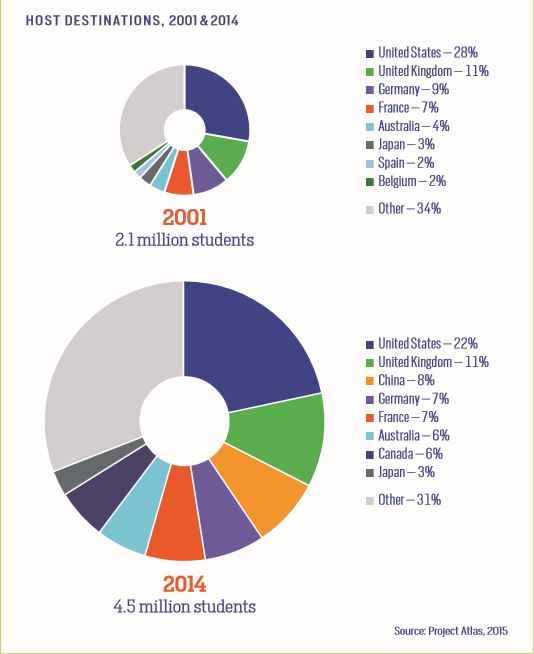There is every reason to believe Asian higher education institutions will soon become superpower education providers. Strong economic capitals, coupled with targeted promotion strategies are definitely key drivers.
A recent high-level trend report from PricewaterhouseCoopers (PwC) predicts that, by 2050, the world will witness a dramatic economy power shift towards Asia, where there is a block of emerging economies with their fast-growing growth.
In fact, Asia’s economy power has fuelled international education mobility for the past decade. As many as 5 million students studied outside of their home countries last year, according to the latest report in international education trend from ICEF Monitor (International Consultants for Education and Fairs). Among these 5 million students, 53% are from Asia. World’s leading sources of international students include China, India (both in the top 10 most powerful economies in the world), and South Korea (top 15 most powerful economies). For easy visualisation, consider 1 of every 6 internationally mobile students is from China. Emerging economies such as Malaysia and Vietnam also have their place in the top 10 sending countries of international students in the United Kingdom and in the United States, respectively, as well as top 5 senders of international students in Australia.
International education is now witnessing promising signs of a change in game plan. Asian countries are targeting to become major receivers of international students. Over the last decade, a number of Asian universities purposely worked to promote themselves using a range of strategies, aiming to become a compelling destination for international students from within the region. Promotion strategies mainly concentrate on ranking improvement, enrolment targets, and financial support.
1. Global ranking
Good ranking indicates an overall highly regarded reputation and education quality. Ranking and academic reputation has been highlighted in several research as the most influential factor in international student’s decision-making while choosing study abroad destinations and providers.
- Asian universities dominate the top spots in the QS Top 50 Under 50 University Rankings (institutions established since 1963) with 6 of the top 10 universities in QS Top 50 Under 50 (2015) are Asian institutions. Hong Kong tops the list of Asian countries featured on top spots in the QS Top 50 Under 50 rankings followed by South Korea and Singapore.
- The number of Asian institutions in the QS global top 50 (2015) has grown from 9 to 12. Singapore tops the list of Asian institutions featured on this list, followed by China, Hong Kong, Japan, and South Korea.
- There was a 17% increase in the number of Asian universities in their global top 200 during the last 5 years. Institutions from China, Hong Kong, and Malaysia mostly accounted for this growth (@Global BU #QS_Asia #HigherEd #GlobalEd).
2. Enrolment targets
International education is no longer a niche area of the economy or the pursuit of a small segment of lucky students: it is measured in millions of study visits and billions of dollars. To ensure a fair share of the pie, Asian institutions have set high enrolment targets.
- China targets to reach 500,000 international students by 2020 after witnessing 10% annual growth since 2010.
- Japan targets to host 300,000 international students by 2020
- South Korea aims to enroll 200,000 international students by 2023
- Malaysia’s goal is to reach 250,000 international students by 2025
3. Financial support
“Pull” factors drawing international students from the region to Asian universities range from Asian governments and universities’ scholarship schemes, to Asia-bound policies from developed countries in the region such as Australia.
There are opportunities to study at world-renowned Asian institutions through several scholarship schemes for international students offered by the governments of Asian countries and top universities. A comprehensive list can be found at Scholars4dev.com.
Asian institutions can also benefit from the Asia-bound policies of developed neighboring countries such as Australia. Large-scale Asia mobility grants and scholarship schemes have been rolled out by the Australian government in order to support Australian higher education students to study and undertake internships in the Asia-Pacific region. Asiabound grant program and New Colombo Plan are the most prominent examples for these incentives. The Australian Department of Foreign Affairs and Trade announced $20 million in New Colombo Plan mobility grants (2016 round) has been awarded to Australian universities to support students to study and undertake work-based experiences in the Indo-Pacific region.
It will be interesting to see how traditional destination markets such as the UK, USA, Australia, New Zealand, and Canada position themselves in this increasing competitiveness.


